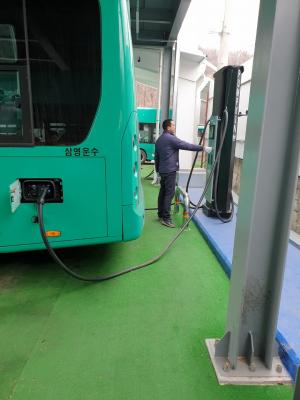
[수원=팍스경제TV 성은숙 기자] The competition for future green mobility, represented by electric vehicles, hydrogen vehicles, and charging infrastructure, is hot with opportunities to respond to the climate crisis, reorganize the post-corona eco-friendly industrial structure, and secure new growth engines for green jobs.
On the other hand, research results show that Korea faces a major obstacle in realizing green mobility due to the lack of charging infrastructure compared to the title of the world’s No. 1 electric vehicle supply and hydrogen vehicle supply.
Gyeonggi Research Institute published the’charging infrastructure that holds back the commercialization of future vehicles’ and argued that the charging infrastructure, which is the starting point for the spread of future mobility, is insufficient compared to demand, and that it should be expanded centering on living bases.
China accounted for 54% of global electric vehicle supply and 40% of charger supply, and Japan and Germany promoted the supply of hydrogen vehicles after establishing the pre-hydrogen charging infrastructure, while supplying hydrogen vehicles far less than Korea, while 490 charging stations worldwide (December 2020 Japan ranked first with 137 and Germany ranked second with 93, compared to 47 and fourth in Korea.
The common electric vehicle chargers in Korea have not been able to keep up with the demand, and operational efficiency has also failed. There are many installations at points and areas with low demand for charging, and insufficient supply and demand mismatch and inefficiency are serious due to lack of installation at points and areas with high demand for charging.
As a result of analyzing the installation points and the amount of charging of public fast electric vehicle chargers, 29.6% of the public rapid electric vehicle chargers installed in public facilities such as city hall occupied the first place in the ranking of installation points, but the average daily charge rate per unit was ranked 4th. It is only 13.7%.
On the other hand, rest facilities are ranked first with 32.6% of their charging capacity, and only 5th with 8.8% of installation sites.
The installation area and charging amount of each city and province are also different.
Gangwon-do and Jeollanam-do, respectively, ranked 5th and 6th in the installation area ranking, ranking only 15th and 16th, while Daegu, Chungcheong-do, and Daejeon have a high ranking of charging, but the ranking of installation areas is in the lowest.
As a result, the current 16.9 units are significantly short of the current 10 units, compared to the 10 units in charge of each common rapid electric vehicle charger, and the goal of supplying new electric vehicles in 2020 is only 60% due to insufficient electric vehicle charging infrastructure centered on the residential and workplace “living bases”. .
The goal was to build 167 hydrogen charging stations by 2020, but only 47, and the achievement rate compared to the government goal is only 28.1%. Among them, 42 charging stations (90%) are located in remote areas such as industrial complexes that are far from downtown, and it is very inconvenient for consumers to charge them.
In addition, opposition from nearby residents, delays in licensing and location restrictions, countermeasures against mediation of conflict in installation by basic local governments, and avoidance of participation in the market by private businesses are acting as obstacles.
A senior research fellow at the Gyeonggi Research Institute, Kang, said, “Because it is possible to lead the era of eco-friendly vehicles through the dissemination of future vehicles, the charging infrastructure must be established first, so the charging infrastructure in the future should be focused on living bases based on charging efficiency and convenience.
The plan is to expand common slow electric vehicle chargers in residences and workplaces, and expand installation of fast chargers at gas stations or LPG charging stations.
Senior Research Fellow Kang Kang added, “It is necessary to expand urban hydrogen refueling stations using gas stations and LNG supply stations, introduce special exceptions for licensing hydrogen refueling stations, and strengthen publicity to eliminate misunderstandings about safety.”
Copyright © Pax Economic TV Unauthorized reproduction and redistribution prohibited
